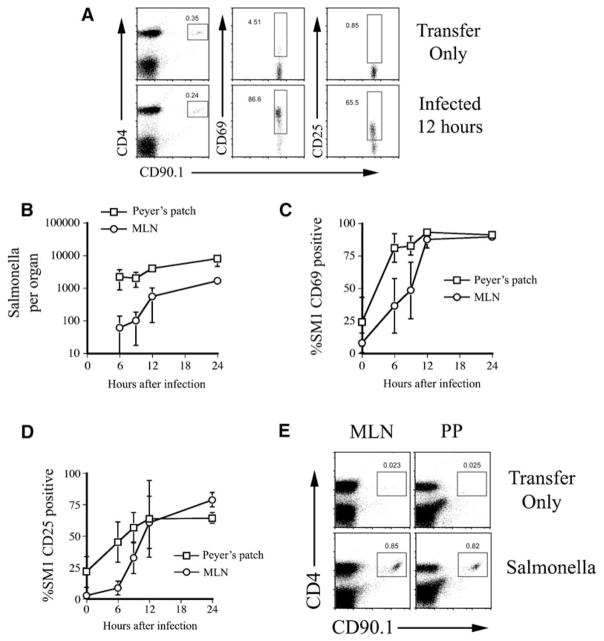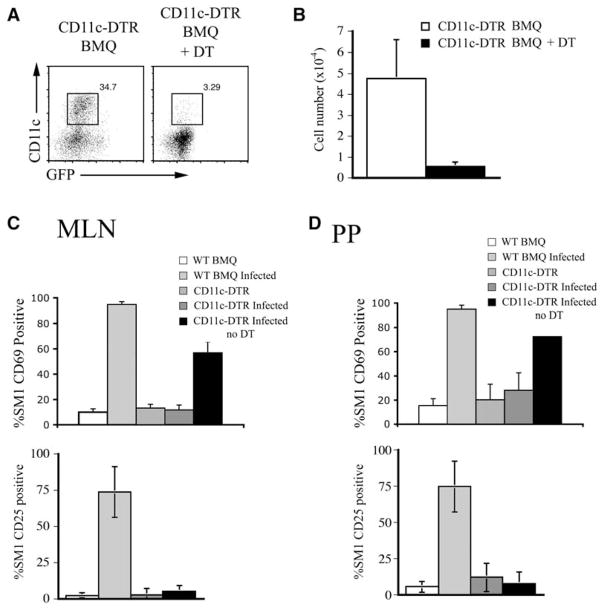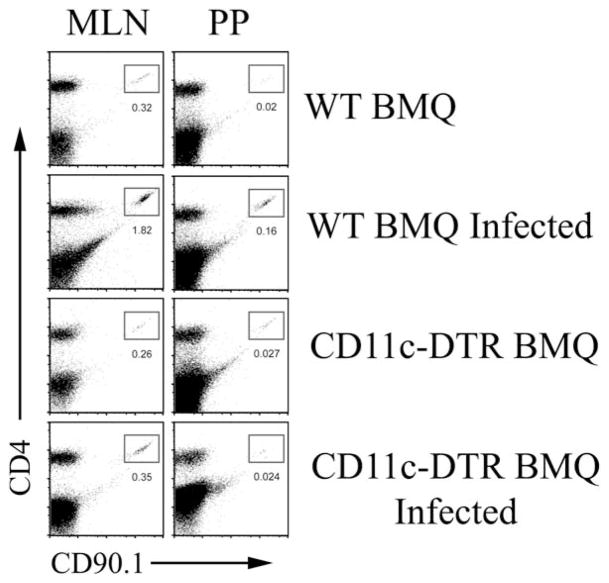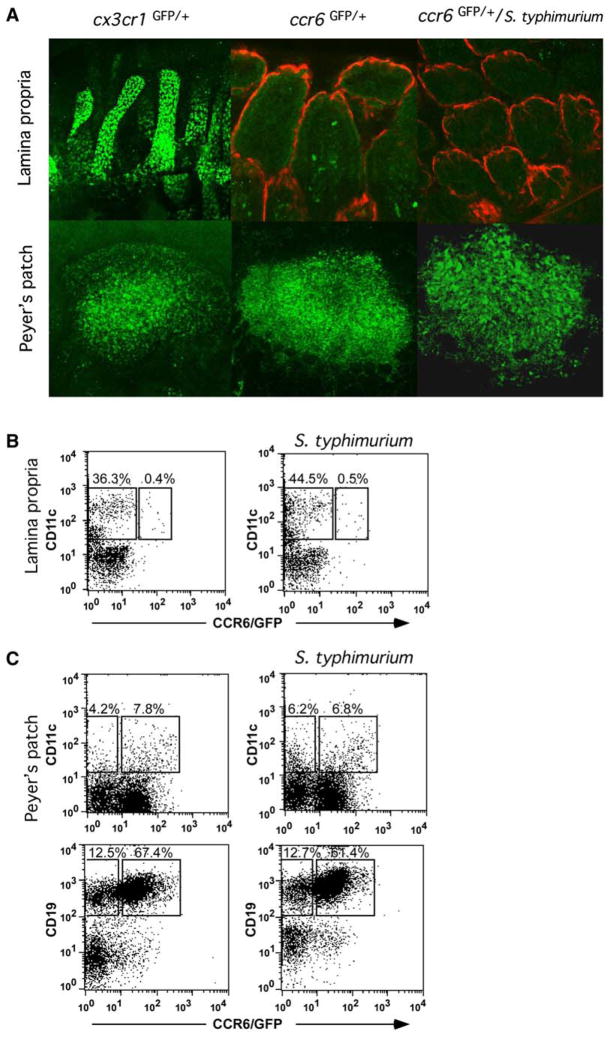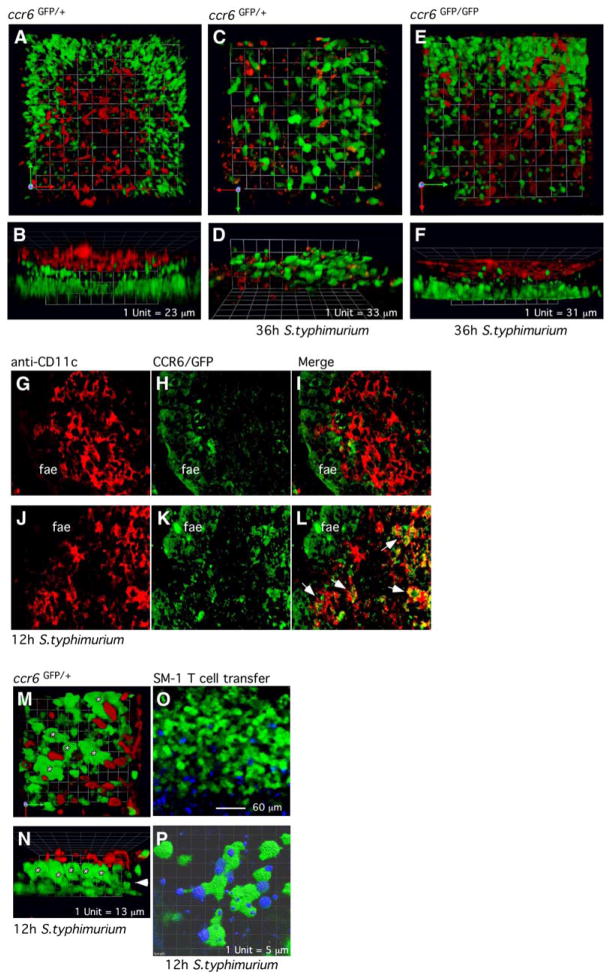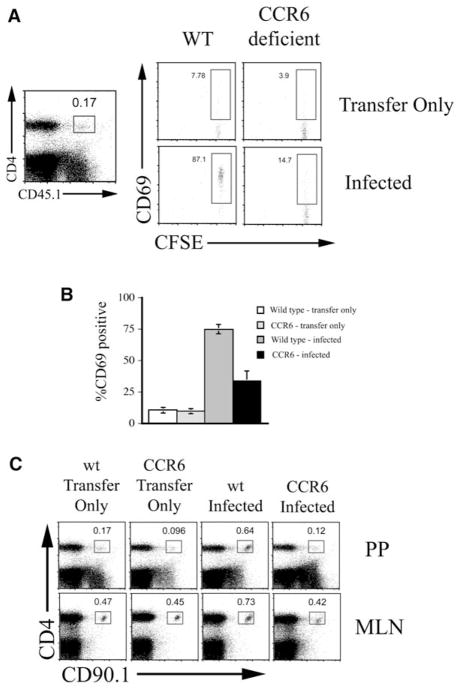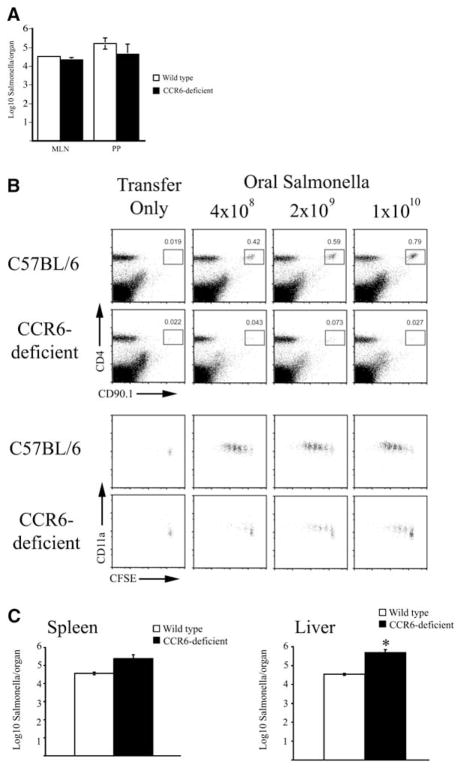Summary
T cell activation by dendritic cells (DCs) is critical to the initiation of adaptive immune responses and protection against pathogens. Here, we demonstrate that a specialized DC subset in Peyer’s patches (PPs) mediates the rapid activation of pathogen specific T cells. This DC subset is characterized by the expression of the chemokine receptor CCR6 and is found only in PPs. CCR6+ DCs were recruited into the dome regions of PPs upon invasion of the follicle associated epithelium (FAE) by an enteric pathogen and were responsible for the rapid local activation of pathogen-specific T cells. CCR6-deficient DCs were unable to respond to bacterial invasion of PPs and failed to initiate T cell activation, resulting in reduced defense against oral infection. Thus, CCR6-dependent regulation of DCs is responsible for localized T cell dependent defense against entero-invasive pathogens.
Introduction
Intestinal mucosal surfaces are continuously exposed to antigens from ingested food products and the microbial flora (Mowat, 2003; Nagler-Anderson, 2001). In addition, the mucosal immune system periodically confronts pathogens that penetrate the intestinal epithelial barrier and invade host tissues (Vazquez-Torres and Fang, 2000). Mucosal lymphoid tissues of the intestine contain anatomical and functional specializations to improve surveillance of the local microbial environment and assist initiation of immune responses (Pabst et al., 2004).
Peyer’s patches (PP) are inductive sites for adaptive immune responses to intestinal antigens and display anatomical and functional similarities to peripheral lymph nodes. However, unlike lymph nodes, PPs do not contain afferent lymphatic drainage or a capsular sinus and simply acquire foreign antigens directly from the intestinal lumen via specialized epithelial microfold cells (M cells) (Neutra et al., 2001; Rimoldi and Rescigno, 2005). A role for dendritic cells (DCs) in the activation of pathogen-specific T cells has been suggested by studies in which orally administered particulate antigens or bacteria were captured by PP DCs. After sampling of antigen, the ability of purified DCs isolated from PPs to induce activation of model antigen- or pathogen-specific T cells has been assessed ex vivo (Fleeton et al., 2004b; Hopkins et al., 2000; Kunkel et al., 2003; Liu and MacPherson, 1993; Pron et al., 2001).
Intestinal DC populations that facilitate antigen sampling, pathogen discrimination, and activation of host defenses determine the consequences of microbial recognition. Recent advances have uncovered diverse mechanisms for the acquisition of intestinal antigens and led to a new appreciation of the organ-specific functional subspecifications of DC subsets (Niess and Reinecker, 2005). However, the function of specific DC subsets associated with different immune compartments of the intestine in adaptive immune responses is unknown. Furthermore, the DC subset responsible for the rapid activation of pathogen-specific T cells and their importance in host defense remains to be defined. Here, we used mouse strains with a deletion or green fluorescent protein (GFP) insertion in CCR6 (the receptor for the chemokine CCL20), an inducible diphtheria toxin (DT) DC depletion system, and S. typhimurium flagellin-specific TCR transgenic mice to identify the DC subset responsible for T cell activation in the PPs. We show that CCR6- mediated regulation of PP DCs is responsible for localized CD4 T cell activation and defense against intestinal pathogens.
Results
S. typhimurium-Specific T Cell Responses Are First Activated in the PP
After adoptive transfer of S. typhimurium flagellin-specific T cells (McSorley et al., 2002) into C57BL/6 mice, a small population of CD4+CD90.1+ SM1 T cells could be detected in the mesenteric lymph nodes (MLNs) (Figure 1A, upper left panel). Naive SM1 cells in the MLNs of uninfected C57BL/6 mice expressed low surface levels of CD69 and CD25 (Figure 1A, upper panels), which increased markedly 12 hr after oral infection with S. typhimurium (Figure 1A, lower panels). As early as 6 hr following oral gavage, S. typhimurium were consistently detected in the PPs but not MLNs, where bacteria first appeared 9–12 hr after infection (Figure 1B). The frequency of SM1 T cells remained similar in the PPs and MLNs of infected and uninfected mice at every time point examined during the first 24 hr after infection (Figure S1). However, the percentage of CD69+ SM1 T cells increased in the PPs as early as 6 hr following S. typhimurium infection and remained elevated for 24 hr (Figure 1C). Most PP SM1 cells also increased surface CD25 expression, although this took slightly longer than the upregulation of CD69 expression, reaching a peak 12 hr after infection (Figure 1D). SM1 T cell activation in the MLNs typically occurred 6 hr after SM1 activation in PPs (Figures 1C and 1D). This short delay in MLN activation corresponded to a delay in S. typhimurium infection of the MLNs (Figure 1B). The rapid activation of T cells in the PPs and MLNs led to the eventual expansion of SM1 T cells at both sites 3 days after oral infection (Figure 1E).
Figure 1. Salmonella-Specific T Cells Are Rapidly Activated in Mucosal Tissues.
C57BL/6 mice were adoptively transferred with SM1 T cells and infected orally with Salmonella.
(A) Plots show representative MLNs from uninfected (Transfer Only) and infected (Infected) mice 12 hr later. Left plots show the box gate for detection of SM1 T cells, and the other plots show the expression of activation markers after gating only on SM1 T cells. Numbers show the percentage of cells within the boxed gate. Data are similar to three mice per group and three other separate experiments.
(B–D) PPs and MLNs were harvested at various times after oral infection. Plots show (B) bacterial burden, percentage of (C) CD69+, and (D) CD25+ SM1 T cells (using similar gates to those in [A]) and show mean ± SD of four mice per time point. Please note logarithmic scale in (B).
(E) PPs and MLNs were harvested 3 days after oral infection. Plots show SM1 T cell detection in each tissue of uninfected (Transfer Only) or infected (Salmonella) mice and are representative of three similar mice per group and three separate experiments.
DCs Are Required for Activation and Expansion of Pathogen-Specific T Cells in the Intestine
We examined the role of gut associated lymphoid tissue (GALT) DCs in the activation of S. typhimurium-specific T cells by using CD11c-DTR transgenic mice that express the diphtheria toxin receptor and GFP under control of the murine CD11c promotor (CD11c-DTR) (Jung et al., 2002). Bone marrow chimeras were established in irradiated C57BL/6 recipients by using marrow from CD11c-DTR or nontransgenic mice as previously described (Zammit et al., 2005). DT treatment eliminated the majority of CD11c+ cells from the PPs of CD11c- DTR but not wild-type (wt) chimeras (Figures 2A and 2B and data not shown). As was observed with unmanipulated C57BL/6 mice (Figure 1), SM1 T cells in the PPs and MLNs of DT-treated wt chimeras increased surface expression of CD69 and CD25 12 hr after oral infection with S. typhimurium (Figures 2C and 2D). Therefore, the establishment of chimerism or treatment with DT did not significantly alter S. typhimurium-specific T cell activation in vivo. Increased CD69 and CD25 expression in response to oral infection did not occur in DT-treated CD11c-DTR chimeras, demonstrating an absolute requirement for CD11c+ DCs for early T cell activation (Figures 2C and 2D). Similarly, the expansion of SM1 T cells 3 days after oral infection with S. typhimurium was severely inhibited in mice lacking DCs (Figure 3). SM1 T cells could be activated to express CD69 in CD11c-DTR chimeras not treated with DT (Figures 2C and 2D), demonstrating that DCs derived from transgenic bone marrow have the capacity to activate SM1 T cells in vivo.
Figure 2. Dendritic Cells Are Required for Rapid Activation of Salmonella-Specific T Cells in GALT.
Wild-type (WT BMQ) and DTR (CD11c-DTR BMQ) BM chimeras were injected with a single dose of 4 ng/g bodyweight of DT and adoptively transferred with SM1 T cells 6–8 hr later. Mice were infected orally the following day with Salmonella, and PPs and MLNs were harvested 12 hr later.
(A and B) PPs were harvested prior to adoptive transfer and DCs identified as MHCII+ CD11c+ (gated cells). Plots show (A) PP MHCII+ cells from CD11c-DTR chimeras with and without DT treatment and (B) the mean number ± SD of DCs in the PPs of each group of mice.
(C and D) Plots show the mean percentage ± SD of CD69+ or CD25+ SM1 T cells in the (C) MLNs, and (D) PPs of uninfected or infected BM chimeras 12 hr after oral infection. SM1 and activation marker gates were set similarly to those shown in Figure 1A. These data are similar to three other separate experiments.
Figure 3. DCs Are Required for the Expansion of Salmonella-Specific T Cells in the GALT.
Wild-type (WT BMQ) and DTR (CD11c-DTR BMQ)BM chimeras were injected with 4 ng/g body weight of DT and adoptively transferred with SM1 T cells 6–8 hr later. Mice were infected orally the following day with Salmonella, and PPs and MLNs were harvested 3 days later. Plots show the percentage of SM1 T cells in uninfected or infected wild-type (WT BMQ) or CD11c-DTR (CD11c-DTR BMQ) BM chimeras and are similar to three individual mice per group.
CCR6+ DCs Are Restricted to PPs and Are Rapidly Recruited into the Follicle-Associated Epithelium upon S. typhimurium Infection
DC subsets in the intestine can be distinguished based on chemokine receptor expression. CCR6+ DCs have been identified in the PPs, while CX3CR1+ DCs populate the entire lamina propria of the intestine and sample the intestinal microbiota through transepithelial dendrites (Iwasaki and Kelsall, 1999a; Kelsall and Strober, 1996; Niess et al., 2005). However, it is not clear whether one particular subset or both participate in the activation of pathogen-specific T cells following oral infection with invasive pathogens.
Analysis of living intestinal tissues of ccr6GFP/+ and cx3cr1GFP/+ mice revealed that CCR6 expression characterizes the immune compartment of PPs. CCR6+ DCs and B cells were found in PPs, while CX3CR1+ DCs populated the entire lamina propria (LP) as well as PPs (Figures 4A, 4B, and 4C and Figure S2). CCR6+ DCs are a distinct subset from CX3CR1+ DCs, which lack expression of CCR6 (Figure 4 and Figure S2). CCR6+ DCs were not recruited to the lamina propria upon Salmonella infection, suggesting that CCR6+ DCs play a defined role in PP-dependent adaptive immune activation against entero-invasive pathogens (Figure 4 and Figure S2).
Figure 4. CCR6 Expression Characterizes the Immune System of PPs.
(A) Confocal fluorescence imaging of living small intestinal mucosa and PPs of cx3cr1GFP/+ and ccr6GFP/+ mice before and 12 hr after oral S. typhimurium infection. Identical studies at 1 hr following bacterial infection produced similar results (data not shown). Red signal indicates epithelial surface staining by Texas-red-labeled wheat germ agglutinin (WEA).
(B) Flow cytometric analysis of leukocytes isolated from the lamina propria or (C) from PPs of ccr6GFP/+ mice after CD11c and CD19 staining.
In ccr6GFP/+ and ccr6GFP/GFP mice, only small GFP positive lymphocytes were occasionally observed within the FAE or the dome regions of PPs (Figures 5A and 5B and Figure S3). In contrast, CX3CR1+ DCs were closely associated with the follicle-associated epithelium (FAE) (Figure S2A). Surprisingly, infection with S. typhimurium caused rapid recruitment of CCR6+ DCs into the FAE of PPs but not into the lamina propria (Figures 5C, 5D, and 5G–5L and Figure S2C).
Figure 5. CCR6+ DCs Migrate into the FAE in Response to Salmonella Infection.
(A–F) Three-dimensional analysis of confocal microscopic image series from living tissues of the most distal PPs in ccr6GFP/+ and ccr6GFP/GFP mice before and after oral S. typhimurium infection. (A), (C), and (E) show 3D reconstructions viewed from the top (luminal side), and (B), (D), and (F) from the side.
(G–L) CD11c Immunofluorescence from acetone- fixed tissues of the follicle associated dome regions in ccr6GFP/+ mice before and after oral S. typhimurium infection. (G–I) Confocal images before S. typhimurium infection and (J–L) 12 hr after S. typhimurium infection. Arrows indicate recruited CCR6+CD11c+ DCs.
(M–P) Three-dimensional analysis of the dome region of PPs in ccr6GFP/+ mice after oral S. typhimurium infection. Living intestinal tissues where incubated with Rhodamine-labeled Ulex europaeus type I lectin (UEA 1) to stain M cells. Arrows indicate the basal membrane; asterisk, intraepithelial DCs. (O and P) Three-dimensional analysis of PPs in ccr6GFP/+ mice 24 hr after transfer of Cell-Tracker-blue-labeled SM-1 transgenic T cells and 12 hr after S. typhimurium infection. Quicktime movies of 3D renderings are supplied as Supplemental Data.
Thirty six hours after S. typhimurium infection, M cells were depleted from the FAE of ccr6GFP/+ mice and a large number of CD11c+/CCR6+ DCs were observed in the dome region, the FAE itself and interfollicular regions (Figures 5C and 5D). Infection-mediated recruitment of these cells required expression of functional CCR6 since CCR6/GFP+ DCs were absent from the FAE of ccr6GFP/GFP mice after challenge with S. typhimurium (Figures 5E and 5F and Figure S3). Recruitment of CCR6+ DCs to the FAE occurred rapidly following infection, and multicellular aggregates of CCR6+ cells were detected in the FAE within 12 hr of infection before the depletion of M-cells occurred (Figures 5M and 5N). CCR6+ DCs infiltrating the epithelium were large cells that extended several processes, had an average volume of 3786 ± 1511 μm3 (n = 21), and were found in direct contact with smaller lymphocytes with an average volume of 353 ± 178 μm3 (n = 25) (Figure S3). These data suggested that local DC-T cell complexes formed beneath the FAE shortly after infection with S. typhimurium. Indeed, adoptively transferred Salmonella-specific SM-1 T cells were integrated into these large CCR6+ DC complexes within 12 hr of oral infection with S. typhimurium (Figures 5O and 5P and Figure S3).
CCR6 Deficiency Impairs the Activation and Expansion of Salmonella-Specific T Cells
Given the rapid establishment of CCR6+ DC/SM1 cell clusters in the FAE following S. typhimurium infection, we sought to establish whether CCR6 expression was required for the activation of S. typhimurium-specific T cells in the PPs and MLNs. SM1 T cells were adoptively transferred into CCR6-deficient or wt mice prior to oral infection with S. typhimurium. A similar percentage of SM1 T cells could be detected in the peripheral lymphoid tissues of both CCR6-deficient and wt recipients (Figure 6C, Transfer Only), indicating that lymph node homing occurred normally in the absence of CCR6. As described above, SM1 T cells in the PPs of wt mice rapidly increased expression of CD69 in response to oral S. typhimurium infection (Figures 6A and 6B). In contrast, the induction of CD69 on SM1 T cells was reduced in CCR6-deficient mice following S. typhimurium infection (Figures 6A and 6B). Furthermore, a profound reduction in SM1 T cell expansion was observed in the PPs and MLNs of CCR6-deficient mice compared to wt, 3 days after infection (Figure 6C). However, although CCR6 expression was required for T cell activation in the GALT after oral infection with Salmonella, it was not required when mice were infected intravenously. SM1 T cells in the spleen of wt and CCR6-deficient mice expanded, increased expression of CD11a, and diluted CFSE to a similar extent following Salmonella infection by the IV route (Figure S4A).
Figure 6. Expression of CCR6 Is Required for Activation of Salmonella- Specific T Cells in GALT.
Wild-type or CCR6-deficient mice were adoptively transferred with SM1 T cells and infected orally with Salmonella.
(A) Plots show PPs from uninfected (Transfer Only) and infected (Infected) mice 12 hr later. Left plot shows representative box gate for detection of SM1 T cells, and other FACS plots show expression of activation markers after gating on SM1 T cells. Data are similar to three other individual experiments.
(B) Plot shows pooled CD69 activation data from three different experiments. Each bar represents the mean and standard deviations (SD) of eight to ten mice per group.
(C) Plots show SM1 T cells in MLNs and PPs from uninfected (Transfer) or infected (oral Salmonella)mice 3 days after oral administration of Salmonella. Each plot is representative of three to four mice per group and three individual experiments.
Given the deficiency in GALT SM1 T cell responses, it was important to establish that S. typhimurium can actually attach to and penetrate the PPs of CCR6-deficient mice. The number of bacteria detected in the PPs and MLNs 12 hr after oral infection of CCR6-deficient mice was similar to wt mice (Figure S4B), indicating that CCR6 was not required for bacterial entry into the PPs or spread to the MLNs. Furthermore, DCs from CCR6- deficient mice displayed no deficiency in the uptake of Salmonella compared to wt DCs (data not shown). Despite similar starting bacterial loads, we detected slightly lower numbers of bacteria in the PPs and MLNs of CCR6-deficient mice 3 days after oral S. typhimurium infection (Figure 7A). Although this difference in bacterial numbers was relatively small and occurred late, it prompted us to reexamine the expansion of SM1 T cells in CCR6-deficient and wt mice over a 25-fold dose range as limited access to antigen could possibly be responsible for lack of SM1 activation in CCR6-deficient mice. SM1 T cells expanded in the PPs of wt mice challenged with 4 × 108, 2 × 109, and 1 × 1010 bacteria, greater expansion occurring in response to higher doses (Figure 7B). These data are in agreement with our previously published reports with this system (Srinivasan et al., 2004b). However, a defect in the expansion of SM1 T cells was observed in CCR6-deficient mice at all doses of Salmonella administered (Figure 7B). SM1 T cells in the PPs of wt mice also had increased expression of CD11a and had undergone several rounds of cell division 3 days after infection with different doses of S. typhimurium (Figure 7B). In contrast, only a small proportion of SM1 T cells increased CD11a expression and diluted CFSE in CCR6-deficient recipients challenged with S. typhimurium (Figure 7B).
Figure 7. Alteration of Infectious Dose Does Not Affect the Requirement for CCR6 in T Cell Activation.
(A) Wild-type and CCR6-deficient mice were orally infected with 1 × 1010 Salmonella, and the number of viable bacteria examined in the PPs and MLNs 3 days later. Plots show the mean and SD of the absolute number of Salmonella per MLN or combined PPs per mouse. Data points represent three mice per group and are similar to two other experiments.
(B) Wild-type or CCR6-deficient mice were adoptively transferred with SM1 T cells, infected orally with 4 × 108–1 × 1010 Salmonella, and PPs harvested 3 days later. Plots show the percentage of SM1 T cells in the PPs (top plots) or CD11a expression and CFSE-dye dilution after gating on PP SM1 T cells (bottom plots). Data are similar to three to four mice per group and two individual experiments.
(C) Wild-type and CCR6-deficient mice were orally infected with 1 × 1010 Salmonella, and the number of viable bacteria examined in the spleens and liver 3 days later. Plots show the mean and SD per organ of 15 mice per group, and asterisk indicates statistically significant difference between data sets.
Lastly, we examined whether CCR6 deficiency had any effect on bacterial numbers in the spleen and liver, the major sites of bacterial replication in vivo. Indeed, CCR6-deficient mice were found to have significantly higher bacterial burdens the liver at day 3 post infection (Figure 7C), suggesting a protective role for CCR6-mediated intestinal T cell activation in vivo.
Discussion
Despite the importance of the GALT as an inductive site during exposure to microbial pathogens, relatively little is known about the early processes of T cell activation in this location. DCs have been shown to capture orally administered antigens in mucosal sites, and purified DCs from mucosal tissues can activate T cells in vitro (Fleeton et al., 2004b; Hopkins et al., 2000; Kunkel et al., 2003; Liu and MacPherson, 1993; Pron et al., 2001). However, our data demonstrate an essential requirement for DCs in the induction of a mucosal T cell response in vivo and suggest a key role for PP DCs in the establishment of protective immunity to mucosal pathogens. The host defense against enteroinvasive pathogens likely involves a number of macrophage and DC subsets, each of which may present antigen. However, presentation in the absence of DCs is insufficient to support S. typhimurium-specific T cell activation and clonal expansion in the mucosal immune system.
Various models have been proposed to explain microbial antigen acquisition by PP DCs (Fleeton et al., 2004a; Iwasaki and Kelsall, 1999b; Ravindran and McSorley, 2005; Yrild and Wick, 2000). Most predict that infection will stimulate directed migration of PP DCs away from the subepithelial dome and toward the interfollicular region (IFR). In marked contrast, our data reveal that a DC subset is rapidly recruited toward the subepithelial dome within hours of oral infection. Such migration is CCR6 dependant since CCR6+ PP DCs in homozygous GFP-knockin mice do not redistribute to the FAE after S. typhimurium infection. Furthermore, this migration occurs despite the presence of a resident CX3CR1+ DC subset already situated beneath the FAE. Although initial reports suggested that CCR6 expression was required for constitutive DC migration to the subepithelial dome (Cook et al., 2000; Varona et al., 2001), a subsequent report using a more sensitive histological technique observed no defect in DC migration (Zhao et al., 2003). Indeed, CD11c+CD11b+ DCs were detected in the subepithelial dome region of the PPs of four different CCR6 deficient lines (Zhao et al., 2003). Our data help reconcile these observations by demonstrating that two distinct DC subsets in PPs are distinguished by either expression of CCR6 or CX3CR1. Both of these DC subsets accumulate in the subepithelial dome, one using a constitutive process and the other being dependent on CCR6 expression and local inflammation for migration. These two populations are distinct since CCR6+ DCs are not found in the lamina propria, and CX3CR1+ PP DCs do not coexpress CCR6.
While CCL20 is expressed by intestinal epithelium in response to Salmonella exposure (Sierro et al., 2001) and CCR6 expression characterizes the immune compartment of PPs, additional signals appear to organize the distribution of immune cells within PPs. For example, although PP B cells express CCR6, they do not aggregate beneath the FAE but appear distributed throughout the PP under homeostatic conditions. Therefore, despite the absolute requirement for CCR6 expression for DC recruitment to the dome, it seems likely that other chemokine receptor-ligand pairs play an additional role in defining the distribution of lymphocytes within the immune compartments of PPs.
CX3CR1+ DCs are located in the PP subepithelial dome and FAE of uninfected mice where they are ideally situated to capture incoming antigens. However, our data demonstrate that CCR6+ DCs in PPs are responsible for the early activation and proliferation of pathogen-specific T cell responses in the GALT. The role of the resident FAE CX3CR1+ DCs during adaptive host responses remains to be determined, but these DCs may be involved in steady-state antigen acquisition from luminal contents and tolerance induction under homeostatic conditions or innate defense activation in response to mucosal pathogens. A recent report demonstrated that close association of dendritic cells with intestinal epithelial cells generates a noninflammatory DC phenotype (Rimoldi et al., 2005). It seems possible that PP CX3CR1+ DCs are ‘‘conditioned’’ in such a manner by their close association with epithelial cells, generating a need for CCR6+ DC migration toward the FAE for the induction of a pathogen-specific immune response in vivo.
Our experiments have not addressed direct Salmonella entry into the lamina propria via invading the epithelium or DC processes that extend across the epithelial layer (Rescigno et al., 2001; Vazquez-Torres et al., 1999). Lamina propria CX3CR1+ DC engage the bacteria in the lamina propria and have been demonstrated to carry commensals and pathogens to MLNs (Niess et al., 2005). Therefore, our data do not rule out the possibility that CX3CR1+ DCs are involved in mediating Salmonella- specific T cell activation at later time points after infection or in other secondary lymphoid tissues.
CCR6-deficient mice are reported to have a reduced number of PP domes, B cells, and M cells, compared to wt mice (Lugering et al., 2005; Varona et al., 2001). However, differences in bacterial entry or replication do not explain defective T cell activation in CCR6-deficient mice since S. typhimurium-specific T cells remained unresponsive across a large challenge dose range. Furthermore, bacterial entry into the PPs of CCR6-deficient mice at 12 hr after infection was similar to wt mice, demonstrating that initial entry of bacteria to the PP is not CCR6 dependant. From these data, it seems unlikely that CCR6+ DCs acquire bacteria by extending processes directly into the lumen, although we have not formally ruled out this possibility. Our data seem more consistent with a model where CCR6+ DCs engulf bacteria after bacterial M cell entry has already occurred.
CCR6 mediated migration to the FAE, and lack of SM1 T cell activation in the PPs correlates with enhanced susceptibility of CCR6-deficient mice to S. typhimurium infection. Surprisingly, we also detected slightly fewer bacteria in the PPs of CCR6-deficient mice 3 days after infection. It is possible that the absence of CCR6 directed T cell activation in the PP allows for greater bacterial dissemination away from the PPs by macrophages or other DC subsets, causing a small reduction in bacterial numbers in the PPs and enhanced bacterial loads in the liver. Thus, the primary function of activated Salmonella- specific T cells in the PPs may be to limit initial bacterial dissemination to other tissue sites. Alternatively, activated PP T cells may migrate to the liver and mediate bacterial killing outside the intestine. Whatever the mechanism, our data indicate that CCR6-dependent pathogen-specific T cell activation in PPs plays an important part of the defense against enteroinvasive pathogens. It remains possible that other DC subsets participate in T cell activation in other lymphoid tissues or at later times after infection. Indeed, we think it likely that defense against enteroinvasive pathogens will involve the simultaneous engagements of distinct DC subsets in both the PP and lamina propria, each of which may have a limited ability to mediate immediate or late activation of T cells or may participate in innate immune clearance.
In conclusion, PPs contain a distinct DC subset that is absolutely required to initiate rapid local S. typhimurium- specific CD4 T cell activation. CCR6 facilitates the attraction of this DC subset into the FAE and is essential for the recognition of mucosal pathogens by T cells in PPs. These CCR6-dependent adaptive immune responses are a critical component of the mucosal defense against entero-invasive pathogens.
Experimental Procedures
Mouse Strains
SM1 Rag-deficient TCR transgenic C57BL/6 mice expressing the Thy1.1 or CD45.1 allele (McSorley et al., 2002; Srinivasan et al., 2004a) and CCR6-GFP mice (Kucharzik et al., 2002) have been reported previously. CD11c-DTR transgenic mice (Jung et al., 2002) and CX3CR1-GFP transgenic mice (Jung et al., 2000) were provided by Drs. Steffen Jung and Dan Littman (Skirball Institute, New York, NY), and CCR6-deficient mice (Cook et al., 2000) were provided by Dr. Sergio Lira (Schering-Plough Research Institute, NJ). C57BL/6 mice were purchased from the National Cancer Institute (Frederick, MD) and used at 8–16 weeks of age. Allmice were housed in specific pathogen-free conditions and cared for in accordance with institutional and NIH guidelines.
Bone Marrow Chimeras
Femurs and tibias were harvested from DTR transgenic or nontransgenic mice, and bone marrow recovered with a syringe. A single cell suspension was generated with a nylon screen. RBCs were lysed with ACK lysis fluid, and cells suspended in HBSS supplemented with HEPES, L-glutamine, Pen/Strep, and gentamycin. Mature T cells were removed by incubation with anti-CD90 ascites fluid (T24) followed by Low-Tox-M rabbit complement (Cedarlane Laboratories, Ontario, Canada) for 45 min at 37°C. After washing, cells were resuspended between 10 × 106 and 25 × 106 cells/ml. Recipient mice were irradiated (1000 rad), and bone marrow cells transferred by IV injection (2 × 106 to 5 × 106/mouse). Mice were rested for 8 weeks before use in experimental protocols.
Treatment of Mice with DT
Mice were administered DT (Sigma, St Louis, MO) in saline by i.p. injection (4 ng/g bodyweight). DTR and wild-type bone marrow chimeras were administered two doses of DT 3 days apart, beginning 1 day prior to S. typhimurium infection.
Adoptive Transfer of SM1 T Cells
Spleen and lymph node cells (inguinal, axillary, brachial, cervical, mesenteric, peri-aortic) were harvested from SM1 Rag-deficient CD90.1 congenic (or CD45.1 congenic) TCR transgenic mice, and a single cell suspension generated by gentle homogenization over a nylon screen. A small aliquot of these cells was stained with antibodies to CD4, CD90.1, CD45.1 (eBioscience, San Diego, CA), and Vβ2 (BD Biosciences, San Diego, CA), and the frequency of SM1 cells determined by flow cytometry with a FACSCalibur (Becton- Dickenson, Mountain View, CA). For in vivo imaging, SM1 transgenic T cells were labeled with 30 μg/ml CellTracker Blue CMAC (7-amino- 4-chloromethylcoumari; Molecular Probes). Spleen and lymph node suspensions were diluted so that 2–5 × 106 SM1 T cells were injected intravenously into recipient mice in a volume of 200 μl. In most experiments, SM1 cells were also stained with CFSE (Parish, 1999) prior to adoptive transfer.
S. typhimurium Infection
Virulent (SL1344) or AroA−D− attenuated (BRD509) S. typhimurium were grown overnight in LB broth without shaking, and OD600 readings of the culture used to estimate bacterial concentration. Bacteria were recovered by centrifugation, diluted in PBS, and used to infect mice orally, as previously described (McSorley et al., 1997). Immediately prior to administration of 5 × 109–1 × 1010 bacteria by gavage, mice were given 0.1 ml of a 5% sodium bicarbonate solution to neutralize stomach acidity. For intravenous infections, 5 × 105 bacteria were injected into the lateral tail vein. In all infection experiments, the actual dose of bacteria administered to mice was confirmed by plating serial dilutions of the sample on MacConkey agar plates.
Recovery of SM1 T Cells and S. typhimurium
At various times after infection, PPs, MLNs or spleens were harvested in Eagle’s Hanks Amino Acids Medium (EHAA) (Biofluids, Rockville, MD) containing 2% fetal bovine serum and 5 mM EDTA. Serial dilutions of each tissue sample were plated onto MacConkey agar plates (Difco, Detroit, MI) and incubated at 37°C to determine bacterial colonization. Remaining cells were then counted, diluted (5 × 106/tube), and stained for flow cytometric analysis.
Isolation of PPs and Small Intestinal Lamina Propria DCs
PPs (approximately 8–12 per mouse) were dissected 24 hr following DT treatment. Organs were subjected to digestion with collagenase D (Roche, Indianapolis, IN) at 37°C for 20–60 min. PPs were crushed between frosted glass slides, washed twice in PBS with 1%BSA and 0.01% NaN3, and then cells were stained with a cocktail of antibodies. Small intestines were inverted on polyethylene tubes (outer diameter 2.08 mm, Becton Dickenson), washed with calcium and magnesium-free phosphate buffered Saline (PBS; Bio Whittaker), and the mucus removed with 1 mM dithiothreitol (DTT; Sigma). The intestinal epithelium was eluted with 30 mM EDTA, followed by digestion of the tissue with 36 U/ml type IV collagenase (Sigma) and 150 μg DNase I (Roche) in 5% FCS/DMEM for 90 min at 37°C in a 5% CO2 humidified atmosphere. The digested tissue was passed through a Cell Strainer (40 μmNylon; BD Falcon) and washed with Dulbecco’s modified Eagle’s medium (DMEM; Cellgro). Final OptiPrep density centrifugation (ρ = 1.055 g/ml; Axis Shield) yielded lamina propria macrophages and DCs.
Flow Cytometry
Cells were incubated on ice for 20–45 min in Fc block (spent culture supernatant from the 24G2 hybridoma, 2% rat serum, 2% mouse serum and 0.01% sodium azide) in the presence of relevant primary antibodies. Fluoroscein isothiocyanate- (FITC), phycoerytherin- (PE), CyChrome-, PE-Cy5-, allophycocyanin-, or biotin-conjugated antibodies specific for CD4, CD11a, CD11c, CD25, CD45.1, CD69, CD90.1, and MHC-II were purchased from eBioscience. Anti-CCR6 antibodies were from Pharmingen. After staining, cells were fixed in paraformaldehyde, washed, and analyzed by flow cytometry with a FACSCalibur. Data were analyzed with FlowJo software (TreeStar, San Carlos, CA).
Confocal Microscopy and 3D Tissue Reconstruction of Living PPs
M cells or intestinal epithelial cells (IECs) of living mucus-free PPs or small intestines were stained with Ulex europaeus agglutinin-1 (UEA-1) conjugated with Rhodamin (Vector Laboratories) or with wheat germ agglutinin (WGA) conjugated with Texas red (Molecular Probes) at concentrations of 20 μg/ml for 1 hr, and living intestinal tissues were imaged with a Bio-Rad Radiance 2000 confocal microscope with multitracking (line switching) for two-color imaging. Hamster anti-mouse CD11c (Serotec) and rabbit-anti-GFP (Santa Cruz Biotechnology) antibodies were used in 1:50 dilutions. In brief, 5 μm cryostat sections were fixed in acetone (30 s, −20°C), blocked with 5% donkey serum/PBS, and incubated with primary antibodies for 2 hr followed by a biotinylated goat anti-hamster and fluorescein goat-anti rabbit secondary antibody (Vector Laboratories) in 1:250 dilutions for 1 hr at RT and incubated with Texas red Streptavidin (1:500, 1 hr, RT; Vector Laboratories). Image acquisition was carried out with LaserSharp Scanning Software and 3D reconstructions and cell volume analysis were completed with Volocity and Slidebook software.
Supplementary Material
Acknowledgments
This work was supported by grants from the National Institutes of Health, AI056172 (L.L., A.T.V., and S.J.M.), AI055743 (S.J.M.), AI142858 (A.T.V.), DK64730 (I.R.W.), DK068181, DK43351 and DK33506 (H.C.R.) and grants from the Crohn’s and Colitis Foundation of America (J.H.N. and S.J.M.).
Footnotes
Supplemental Data include figures and eight movies and are available at http://www.immunity.com/cgi/content/full/24/5/623/DC1/.
References
- Cook DN, Prosser DM, Forster R, Zhang J, Kuklin NA, Abbondanzo SJ, Niu XD, Chen SC, Manfra DJ, Wiekowski MT, et al. CCR6 mediates dendritic cell localization, lymphocyte homeostasis, and immune responses in mucosal tissue. Immunity. 2000;12:495–503. doi: 10.1016/s1074-7613(00)80201-0. [DOI] [PubMed] [Google Scholar]
- Fleeton M, Contractor N, Leon F, He J, Wetzel D, Dermody T, Iwasaki A, Kelsall B. Involvement of dendritic cell subsets in the induction of oral tolerance and immunity. Ann N Y Acad Sci. 2004a;1029:60–65. doi: 10.1196/annals.1309.008. [DOI] [PubMed] [Google Scholar]
- Fleeton MN, Contractor N, Leon F, Wetzel JD, Dermody TS, Kelsall BL. Peyer’s patch dendritic cells process viral antigen from apoptotic epithelial cells in the intestine of reovirus-infected mice. J Exp Med. 2004b;200:235–245. doi: 10.1084/jem.20041132. [DOI] [PMC free article] [PubMed] [Google Scholar]
- Hopkins SA, Niedergang F, Corthesy-Theulaz IE, Kraehenbuhl JP. A recombinant Salmonella typhimurium vaccine strain is taken up and survives within murine Peyer’s patch dendritic cells. Cell Microbiol. 2000;2:59–68. doi: 10.1046/j.1462-5822.2000.00035.x. [DOI] [PubMed] [Google Scholar]
- Iwasaki A, Kelsall BL. Freshly isolated Peyer’s patch, but not spleen, dendritic cells produce interleukin 10 and induce the differentiation of T helper type 2 cells. J Exp Med. 1999a;190:229–239. doi: 10.1084/jem.190.2.229. [DOI] [PMC free article] [PubMed] [Google Scholar]
- Iwasaki A, Kelsall BL. Mucosal immunity and inflammation. I Mucosal dendritic cells: their specialized role in initiating T cell responses. Am J Physiol. 1999b;276:G1074–G1078. doi: 10.1152/ajpgi.1999.276.5.G1074. [DOI] [PubMed] [Google Scholar]
- Jung S, Aliberti J, Graemmel P, Sunshine MJ, Kreutzberg GW, Sher A, Littman DR. Analysis of fractalkine receptor CX(3)CR1 function by targeted deletion and green fluorescent protein reporter gene insertion. Mol Cell Biol. 2000;20:4106–4114. doi: 10.1128/mcb.20.11.4106-4114.2000. [DOI] [PMC free article] [PubMed] [Google Scholar]
- Jung S, Unutmaz D, Wong P, Sano G, De los Santos K, Sparwasser T, Wu S, Vuthoori S, Ko K, Zavala F, et al. In vivo depletion of CD11c(+) dendritic cells abrogates priming of CD8(+) T cells by exogenous cell-associated antigens. Immunity. 2002;17:211–220. doi: 10.1016/s1074-7613(02)00365-5. [DOI] [PMC free article] [PubMed] [Google Scholar]
- Kelsall BL, Strober W. Distinct populations of dendritic cells are present in the subepithelial dome and T cell regions of the murine Peyer’s patch. J Exp Med. 1996;183:237–247. doi: 10.1084/jem.183.1.237. [DOI] [PMC free article] [PubMed] [Google Scholar]
- Kucharzik T, Hudson JT, 3rd, Waikel RL, Martin WD, Williams IR. CCR6 expression distinguishes mouse myeloid and lymphoid dendritic cell subsets: demonstration using a CCR6 EGFP knock-in mouse. Eur J Immunol. 2002;32:104–112. doi: 10.1002/1521-4141(200201)32:1<104::AID-IMMU104>3.0.CO;2-C. [DOI] [PubMed] [Google Scholar]
- Kunkel D, Kirchhoff D, Nishikawa S, Radbruch A, Scheffold A. Visualization of peptide presentation following oral application of antigen in normal and Peyer’s patches-deficient mice. Eur J Immunol. 2003;33:1292–1301. doi: 10.1002/eji.200323383. [DOI] [PubMed] [Google Scholar]
- Liu LM, MacPherson GG. Antigen acquisition by dendritic cells: intestinal dendritic cells acquire antigen administered orally and can prime naive T cells in vivo. J Exp Med. 1993;177:1299–1307. doi: 10.1084/jem.177.5.1299. [DOI] [PMC free article] [PubMed] [Google Scholar]
- Lugering A, Floer M, Westphal S, Maaser C, Spahn TW, Schmidt MA, Domschke W, Williams IR, Kucharzik T. Absence of CCR6 inhibits CD4+ regulatory T-cell development and M-cell formation inside Peyer’s patches. Am J Pathol. 2005;166:1647–1654. doi: 10.1016/S0002-9440(10)62475-3. [DOI] [PMC free article] [PubMed] [Google Scholar]
- McSorley SJ, Xu D, Liew FY. Vaccine efficacy of Salmonella strains expressing glycoprotein 63 with different promoters. Infect Immun. 1997;65:171–178. doi: 10.1128/iai.65.1.171-178.1997. [DOI] [PMC free article] [PubMed] [Google Scholar]
- McSorley SJ, Asch S, Costalonga M, Rieinhardt RL, Jenkins MK. Tracking Salmonella-specific CD4 T cells in vivo reveals a local mucosal response to a disseminated infection. Immunity. 2002;16:365–377. doi: 10.1016/s1074-7613(02)00289-3. [DOI] [PubMed] [Google Scholar]
- Mowat AM. Anatomical basis of tolerance and immunity to intestinal antigens. Nat Rev Immunol. 2003;3:331–341. doi: 10.1038/nri1057. [DOI] [PubMed] [Google Scholar]
- Nagler-Anderson C. Man the barrier! Strategic defenses in the intestinal mucosa. Nat Rev Immunol. 2001;1:59–67. doi: 10.1038/35095573. [DOI] [PubMed] [Google Scholar]
- Neutra MR, Mantis NJ, Kraehenbuhl JP. Collaboration of epithelial cells with organized mucosal lymphoid tissues. Nat Immunol. 2001;2:1004–1009. doi: 10.1038/ni1101-1004. [DOI] [PubMed] [Google Scholar]
- Niess JH, Reinecker HC. Lamina propria dendritic cells in the physiology and pathology of the gastrointestinal tract. Curr Opin Gastroenterol. 2005;21:687–691. doi: 10.1097/01.mog.0000181710.96904.58. [DOI] [PubMed] [Google Scholar]
- Niess JH, Brand S, Gu X, Landsman L, Jung S, McCormick BA, Vyas JM, Boes M, Ploegh HL, Fox JG, et al. CX3CR1-mediated dendritic cell access to the intestinal lumen and bacterial clearance. Science. 2005;307:254–258. doi: 10.1126/science.1102901. [DOI] [PubMed] [Google Scholar]
- Pabst O, Herbrand H, Bernhardt G, Forster R. Elucidating the functional anatomy of secondary lymphoid organs. Curr Opin Immunol. 2004;16:394–399. doi: 10.1016/j.coi.2004.05.014. [DOI] [PubMed] [Google Scholar]
- Parish CR. Fluorescent dyes for lymphocyte migration and proliferation studies. Immunol Cell Biol. 1999;77:499–508. doi: 10.1046/j.1440-1711.1999.00877.x. [DOI] [PubMed] [Google Scholar]
- Pron B, Boumaila C, Jaubert F, Berche P, Milon G, Geissmann F, Gaillard JL. Dendritic cells are early cellular targets of Listeria monocytogenes after intestinal delivery and are involved in bacterial spread in the host. Cell Microbiol. 2001;3:331–340. doi: 10.1046/j.1462-5822.2001.00120.x. [DOI] [PubMed] [Google Scholar]
- Ravindran R, McSorley SJ. Tracking the dynamics of T-cell activation in response to Salmonella infection. Immunology. 2005;114:450–458. doi: 10.1111/j.1365-2567.2005.02140.x. [DOI] [PMC free article] [PubMed] [Google Scholar]
- Rescigno M, Urbano M, Valzasina B, Francolini M, Rotta G, Bonasio R, Granucci F, Kraehenbuhl JP, Ricciardi-Castagnoli P. Dendritic cells express tight junction proteins and penetrate gut epithelial monolayers to sample bacteria. Nat Immunol. 2001;2:361–367. doi: 10.1038/86373. [DOI] [PubMed] [Google Scholar]
- Rimoldi M, Rescigno M. Uptake and presentation of orally administered antigens. Vaccine. 2005;23:1793–1796. doi: 10.1016/j.vaccine.2004.11.007. [DOI] [PubMed] [Google Scholar]
- Rimoldi M, Chieppa M, Salucci V, Avogadri F, Sonzogni A, Sampietro GM, Nespoli A, Viale G, Allavena P, Rescigno M. Intestinal immune homeostasis is regulated by the cross-talk between epithelial cells and dendritic cells. Nat Immunol. 2005;6:507–514. doi: 10.1038/ni1192. [DOI] [PubMed] [Google Scholar]
- Sierro F, Dubois B, Coste A, Kaiserlian D, Kraehenbuhl JP, Sirard JC. Flagellin stimulation of intestinal epithelial cells triggers CCL20-mediated migration of dendritic cells. Proc Natl Acad Sci USA. 2001;98:13722–13727. doi: 10.1073/pnas.241308598. [DOI] [PMC free article] [PubMed] [Google Scholar]
- Srinivasan A, Foley J, McSorley SJ. Massive number of antigen-specific CD4 T cells during vaccination with live attenuated Salmonella causes interclonal competition. J Immunol. 2004a;172:6884–6893. doi: 10.4049/jimmunol.172.11.6884. [DOI] [PubMed] [Google Scholar]
- Srinivasan A, Foley J, Ravindran R, McSorley SJ. Low-dose Salmonella infection evades activation of flagellin-specific CD4 T cells. J Immunol. 2004b;173:4091–4099. doi: 10.4049/jimmunol.173.6.4091. [DOI] [PubMed] [Google Scholar]
- Varona R, Villares R, Carramolino L, Goya I, Zaballos A, Gutierrez J, Torres M, Martinez AC, Marquez G. CCR6-deficient mice have impaired leukocyte homeostasis and altered contact hypersensitivity and delayed-type hypersensitivity responses. J Clin Invest. 2001;107:R37–R45. doi: 10.1172/JCI11297. [DOI] [PMC free article] [PubMed] [Google Scholar]
- Vazquez-Torres A, Fang FC. Cellular routes of invasion by enteropathogens. Curr Opin Microbiol. 2000;3:54–59. doi: 10.1016/s1369-5274(99)00051-x. [DOI] [PubMed] [Google Scholar]
- Vazquez-Torres A, Jones-Carson J, Baumler AJ, Falkow S, Valdivia R, Brown W, Le M, Berggren R, Parks WT, Fang FC. Extraintestinal dissemination of Salmonella by CD18-expressing phagocytes. Nature. 1999;401:804–808. doi: 10.1038/44593. [DOI] [PubMed] [Google Scholar]
- Yrild U, Wick MJ. Salmonella-induced apoptosis of infected macrophages results in presentation of a bacteria-encoded antigen after uptake by bystander dendritic cells. J Exp Med. 2000;191:613–623. doi: 10.1084/jem.191.4.613. [DOI] [PMC free article] [PubMed] [Google Scholar]
- Zammit DJ, Cauley LS, Pham QM, Lefrancois L. Dendritic cells maximize the memory CD8 T cell response to infection. Immunity. 2005;22:561–570. doi: 10.1016/j.immuni.2005.03.005. [DOI] [PMC free article] [PubMed] [Google Scholar]
- Zhao X, Sato A, Dela Cruz CS, Linehan M, Luegering A, Kucharzik T, Shirakawa AK, Marquez G, Farber JM, Williams I, Iwasaki A. CCL9 is secreted by the follicle-associated epithelium and recruits dome region Peyer’s patch CD11b+ dendritic cells. J Immunol. 2003;171:2797–2803. doi: 10.4049/jimmunol.171.6.2797. [DOI] [PubMed] [Google Scholar]
Associated Data
This section collects any data citations, data availability statements, or supplementary materials included in this article.



